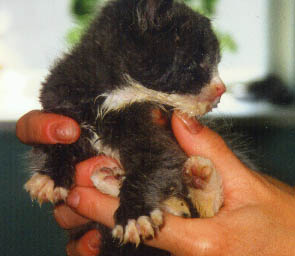Animal Advocates Watchdog
Why would the SPCA want to shut down the cat rescuers? Perhaps because they drain away hundreds of thousands of dollars in donations from cat-lovers? Or perhaps because they make the SPCA look heartless and money-hungry by comparison with their selfless work? Or both?
AAS warned that this would happen and were quickly proven right. The Vancouver SPCA acted aggressively to intimidate long-time cat rescuer and shelterer, Madalynn Gilmore.
From Nicholas Read, Vancouver Sun, March 2, 1999 - SPCA tries to shut down cat-rescuer Madalyn Gilmore:
"The SPCA’s relationship with other animal organizations has not always been an easy one. SPCA involvement is essential to getting progressive legislation enacted, but because the SPCA has always been so reluctant to speak out on any issue, that involvement has rarely been forthcoming. Thus its vociferous support for spay/neuter campaigns is a welcome surprise.
"Nevertheless, the unease remains. Late last month, a Langley inspector turned up unexpectedly at the Aldergrove home of Madalynn Gilmore to warn her against taking in strays. Gilmore has been rescuing cats and other animals for 20 years, putting everything she has into finding them good homes. It doesn’t matter how sick the animal is when it arrives, Gilmore takes responsibility for the vet bills, as well as the injections and the spaying or neutering. A single cat can cost her hundreds of dollars to care for.
"Yet here was the SPCA telling her that after 20 years, it wasn’t legal for her to pick up strays and "sell" them anymore. Animals are considered property under Canadian law. Therefore only the SPCA and municipal pounds have the authority to pick up strays and release them to new owners.
"Granted, but Gilmore always notifies the SPCA of every stray she collects. Also, only five per cent of stray cats picked up by the SPCA are returned to owners. Strays left on the street are strays left to die.
"Brian Nelson, SPCA director of field operations, says the inspector was only doing his job, and had no intention of harassing Gilmore.
"Perhaps, but Lisa Borsato, a woman who had brought in a cat for Gilmore to look after, told me: "He made it seem like she was a criminal."
"Whatever the truth, it’s not an image the SPCA can afford to have – that of the uncaring, rule-bound bully. Not if it is going to win the trust it wants.
"It has gone some distance to ward shedding the image recently, but incidents like this don’t help.
"If spay/neuter legislation is going to work, it must not allow the SPCA to trouble people helping to solve the problem. Not when there are still so many more people making it worse."
Nick Read, Vancouver Sun. 1999
AAS: After years of blocking and stonewalling legislation to help reduce the cat carnage caused by overpopulation; of refusing to help, or of even acknowledging the struggling and impoverished cat rescue network, the SPCA was suddenly front and centre taking credit when a coalition of cat groups, led by Vancouver Humane Society, got Surrey and Coquitlam to adopt mandatory cat spay/neuter bylaws. Did the SPCA "get on board" because to be seen publicly to be blocking this would be too revealing? Or could it be because the VHS promoted bylaw included a section that permitted "round-up-and-kill" of all feral cats, and most stray cats, and here was an opportunity for the SPCA to add cat control to their eighteen dog control pound contracts in the lower mainland, and therefore boost their contract prices? Or was it the chance to shut down the no-kill cat rescue network by forcing the rescuers to take cats to the SPCA/Pound, to be killed? After all, the cat rescue network may drain away as much as a quarter of a million dollars a year in donations, and they make the SPCA look bad. Or was it all three?
AAS believes that all the councillors who voted for this legislation meant well but did not understand that the legislation they thought was entirely cat-friendly was actually "round-up-and-kill".
AAS has asked municipalities to consider our control of breeding proposal "Too Many Cats" instead of round-up-and-kill legislation. Animal Advocates has asked the mayors and councillors in the municipalities that unknowingly adopted "round-up-and-kill" legislation to consider if they would apply the same legislated solution to other animals that live near human habitation, and which many people consider pests, such as raccoons, squirrels, coyotes and bears.
We have been told that where it has been adopted, that it has not worked. We knew it wouldn't. No municipality can afford the huge number of man-hours it would take to enforce this useless, harmful bylaw. Only litters of kittens should be controlled, because only they are the problem. An unsterilized cat is not the problem, if it is not reproducing. And because people must advertise that they have kittens for sale or for free, then it is easy to control the production of kittens by licensing the production of kittens. Licensing actual reproduction also allows for inspection of the health of the kittens and the mother cat at the same time.

Messages In This Thread
- Animal Rights Coalition: Why mandatory spay/neuter doesn't work: Cross-posted from the Brindleweb board *LINK*
- VHS/SPCA round-up-and-kill bylaws *LINK*
- "TOO MANY CATS": AAS proposed Anti-Litter Law *LINK* *PIC*
- The politics of cat control legislation and groups: The SPCA tries to shut down Madalynn Gilmore *PIC*
- "TOO MANY CATS": AAS proposed Anti-Litter Law *LINK* *PIC*
- VHS/SPCA round-up-and-kill bylaws *LINK*